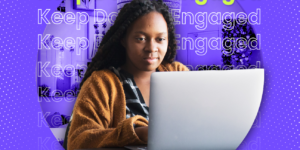As you know, being personal and relevant is a critical component of any fundraising strategy. So, it’s important to consider the current state of your relationship with any donor before you ask for support. After all, your at-risk donors will need to hear a very different message than your most engaged supporters if you want them to give again at the year-end.
You can consider anyone who has given to your organization in the past but not within the last year as at risk of lapsing. But these individuals are not a lost cause. They just need to hear a different message.
Several factors can explain a lapsed gift. But not all of them are within your control.
So, don’t assume an at-risk donor is no longer interested in helping your nonprofit reach its goals!
According to the latest data from the Fundraising Effectiveness Project, only 11 percent of new donors acquired in 2024 have given again so far in 2025.
So, as you’re gearing up for your next appeal, create a segment for donors who supported your annual fund or another major initiative last year but have yet to give in 2025. Then, use the following advice to open a dialogue and encourage your at-risk donors to join in and help your organization achieve its mission once again.

Speak to at-risk donors directly.
Donor retention is never easy, especially when supporters start to drift away. But it’s far more cost effective to keep a donor engaged than it is to win them back after they’ve stopped giving.
So, don’t treat at-risk donors like strangers. Use the data you already have to speak to their unique connection with your organization. Look at past giving patterns, donation amounts, and the programs they’ve supported.
If you can, try to understand why they haven’t supported you yet this year. Is it timing? Uncertainty? A lack of clarity around where their dollars go? The more insight you have, the better your chance of rekindling their support before they lapse for good.
LEARN MORE: How to segment your nonprofit’s audience.

What have they heard lately?
What were the last few communications each at-risk donor received? And have they been opening and clicking your emails but stopping before making a gift? Or are your messages being marked as spam?
It is a huge red flag if you send appeal after appeal without messages in between that build relationships and keep donors engaged.
Donor fatigue is a real concern. Fundraisers need to vary their messages and reach out with different types of communications to retain donors long-term.
So, look for ways to add extra touches in your outreach strategy.
Let’s say the last time a donor heard from you was when you invited them to your annual awards dinner. They didn’t attend, and that’s OK!
But what’s not OK is if they don’t hear from you for months before you hit them with an appeal.
It’s important to balance your messages. So, consider sending a newsletter about the event to follow up. Highlight award winners and other important moments from the night to keep your donors in the loop.
The worst thing an organization can do is make their donors feel like a source of income. The donor/organization relationship is supposed to be a partnership. One where you work together to achieve a shared goal. So, make sure your supporters know you care about more than their next gift.
LEARN MORE: When communications flow, relationships grow!

Thank them for past support.
When a new or repeat donor makes a gift, we know we need to thank them promptly. However, one of the reasons your donor retention rate may be suffering is because your thank you’s don’t do much more than say “thanks!”
When someone holds the door open for you, a simple “thanks” will suffice. But you need to do more when someone opens their wallet and helps you advance your mission!
Include pictures of the people you serve and invite at-risk donors to participate in volunteer opportunities so they can make a bigger impact without another financial contribution.
Your supporters will not stick around if you’re not putting enough effort into your stewardship strategy. At-risk donors need to understand the difference their past support has made. And you need to let these supporters know your organization is counting on them so you can make a bigger impact together.
LEARN MORE: Does your nonprofit need to send better thank you’s?
Create a special version of your year-end appeal.
But don’t do all this work just to send your at-risk donors the same appeal you send current donors!
As you know, segmenting your audience and versioning your outreach for each group is one of the best ways to make your message rise above the noise.
Your data can help you determine the right ask for at-risk donors. So, consider using an at-risk donor’s last gift as the high-end ask to make renewing their gift an easier decision.
And don’t forget to consider how to adapt your message itself.
Start by sharing a little about everything your organization has accomplished since the last time a donor gave. Then, let them know the impact they can make by renewing their support. You can use variable data to specify the date and dollar amount of past contributions for each donor, making the information even more personal.
But remember, you’re not trying to make at-risk donors feel guilty for not giving to your organization. You want to nurture and rekindle the relationship you have with them.
Think about your outreach to at-risk donors as if you were reaching out to an old friend. It’s about touching base and seeing if you can pick up where you left off, maybe over a cup of coffee. So, you shouldn’t sound desperate like someone begging an ex-partner to give them another chance!
Want to build a plan for at-risk donors with an amplifi team member? Click here!









